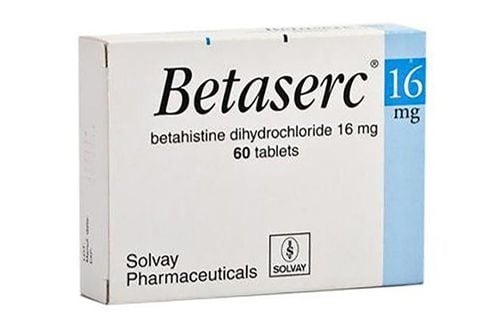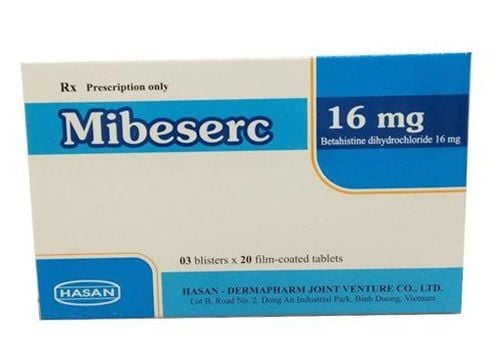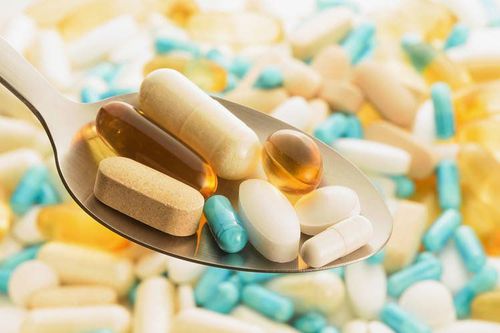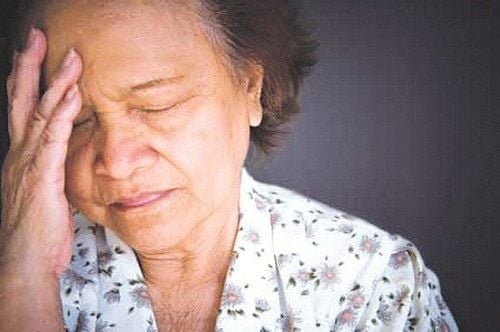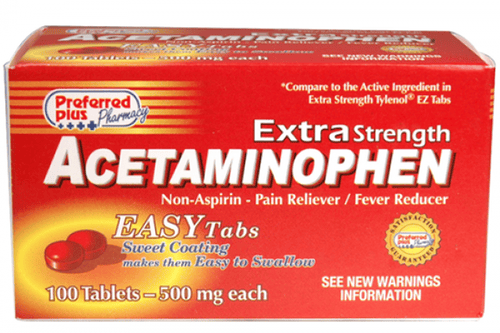This is an automatically translated article.
Vinphastu 25mg is often used to treat diseases related to symptoms originating from cerebral vessels, such as dizziness, tinnitus, headache with vascular causes, lack of concentration.... To better understand What are the uses of Vinphastu 25mg? What are the side effects of Vinphastu 25mg? What is the correct way to drink? What are the points to pay attention to when using? The following article will help you better understand Vinphastu 25mg.
1. What is Vinphastu 25mg?
Vinphastu has the main ingredient Cinnarizine, belongs to the group of psychotropic drugs, prepared in the form of 25mg tablets, produced by Vinh Phuc Pharmaceutical Joint Stock Company (Vinphaco) - Vietnam.Vinphastu 25mg is prescribed by doctors in the following cases:
Maintenance treatment of labyrinthine disorders, including dizziness, lightheadedness, tinnitus, nausea and vomiting, eye twitching; symptoms of cerebrovascular origin, such as tinnitus, dizziness, vascular headache, irritability, lack of concentration and memory loss; peripheral circulatory disorders, such as Raynaud's, claudication, nutritional disorders, acromegaly, ulceration of the extremities. Effective in controlling motion sickness Prevention of migraine headaches.
2. What is the effect of Vinphastu 25mg?
2.1 Mechanism of Action Cinnarizine has been shown to be a non-competitive antagonist of smooth muscle contractions induced by various vasoactive agents including (histamine, angiotensin, bradykinin, nicotine, acetylcholine) , adrenaline, noradrenaline, BaCl2) and induced by KCl depolarization. Specific antispasmodic activity was observed on vascular smooth muscle. Cinnarizine acts on the contractile response of depolarized smooth muscle fibers by selectively inhibiting the influx of calcium ions into depolarized cells thereby minimizing the presence of calcium ions required for the induction and maintenance of contraction. muscle. Cinnarizine is nontoxic and does not interfere with important physiological functions (central nervous system, circulatory function, respiratory function).
Clinical efficacy and safety Cinarizin is a piperazine derivative with H1 antihistamine activity. Most H-antihistamines also have anticholinergic and sedative effects. Antihistamines can block receptors in the vestibular terminal organs and inhibit the activation of histamine and acetylcholine secretion. For motion sickness prevention, antihistamines are slightly less effective than scopolamine (hyoscin), but are generally better tolerated, and less drowsy antihistamines such as cinarizin or cyclizin are often preferred.
The ocular vestibular reflex induced by thermal stimulation of the maze in cinnarizine-induced guinea pigs is markedly impaired.
Cinnarizine has been shown to inhibit nystagmus.
2.2 Pharmacokinetics In animals, cinnarizine is extensively metabolised, with N-dealkylation being the primary pathway. Approximately two-thirds of the metabolites are excreted in the feces, with the remainder in the urine, mainly during the first five days after a single dose.
Absorption In humans, after oral administration, absorption is relatively slow, with peak serum concentrations occurring after 2.5 to 4 hours.
Distribution The plasma protein binding of cinnarizine is 91%
Bioconversion Cinnarizine undergoes extensive metabolism mainly via CYP2D6 but there is significant inter-individual variation in the extent of metabolism.
Elimination Approximately 2/3 of the metabolite is excreted in the feces, the remainder in the urine (unchanged as metabolites and glucuronide conjugates), mainly during the first five days after a single dose. best.
The reported half-life of cinnarizine is between 4 and 24 hours.
2.3 Contraindications Patients with hypersensitivity to any component or excipients of Vinphastu 25mg Porphyrin metabolism disorder. 2.4 Side effects of Vinphastu 25mg Common
Central nervous system disorders: Somnolence Digestive: Digestive disorders, nausea Uncommon:
Central nervous system disorders: Headache Gastrointestinal: Uncontrolled weight gain control, dry mouth Night sweats, mild allergies Rare:
Central nervous system disorders: When treating in the elderly group, there are signs of extrapyramidal symptoms. Cardiovascular: reduced blood pressure 2.5 Drug interactions Concomitant use of alcohol, CNS depressants or tricyclic antidepressants may potentiate the sedative effects of these drugs or of cinnarizine.
Vinphastu can interact with any other drugs?
Remember that drug interactions with other drugs are often quite complicated due to the influence of many ingredients in the drug. Studies or recommendations usually only state common interactions with use. Therefore, do not arbitrarily apply information about Vinphastu drug interactions if you are not a researcher, doctor or medical person.
Vinphastu drug interactions with food and drinks
Consider using the same drug with alcohol, tobacco, alcoholic or fermented beverages. Factors that can change the composition of the drug. See details in the leaflet or consult your doctor or pharmacist for more details.
2.6. Note when using Vinphastu Like other antihistamines, Vinphastu 25mg may cause epigastric discomfort; Taken after meals can reduce stomach irritation. Vinphastu should only be used in Parkinson's patients if the advantages outweigh the potential risks of aggravating the disease. Due to its antihistamine effects, Vinphastu 25mg can prevent a positive reaction to skin reaction indicators if used within 4 days before testing. The drug can cause drowsiness, especially in the early stages of taking the drug, so caution should be taken when used with alcohol or other CNS depressants. Long-term use of Vinphastu 25mg should be avoided in the elderly, because it may cause an increase or appearance of extrapyramidal symptoms, sometimes associated with feelings of depression during prolonged treatment. Caution should be exercised when using high doses of Vinphastu for patients with low blood pressure because it may cause a decrease in blood pressure. Vinphastu can cause drowsiness, so patients need to be careful when driving and operating machinery The drug can prevent positive reactions to skin reaction indicators if used within 4 days before testing a skin reaction. There are no specific studies on liver or kidney dysfunction. Vinphastu 25mg should be used with caution in patients with hepatic or renal impairment. Vinphastu tablets contain lactose. Patients with rare hereditary problems of galactose intolerance, the Lapp lactase deficiency or glucose-galactose malabsorption should not take this medicine. The safety of Vinphastu in human pregnancy has not been established, although animal studies have not demonstrated teratogenic effects. Like other drugs, Vinphastu should not be used during pregnancy
3. How to use Vinphastu 25mg effectively?
3.1. Dosage Adults: + Cerebral circulatory disorders 1 tablet x 3 times/day. + Peripheral circulatory disorders 2-3 tablets x 3 times/day. + Dizziness 1 tablet x 3 times/day. + Motion sickness adults: 1 tablet half an hour before the trip, repeat every 6 hours. Children: half the adult dose. The maximum recommended dose should not exceed 225mg per day. Should be used after meals. 3.2. Overdose Symptoms: The signs and symptoms are mainly due to the anticholinergic (atropine-like) activity of cinnarizine.
Acute overdosage of cinnarizine has been reported at doses ranging from 90 to 2,250 mg. Changes in consciousness, ranging from lethargy to stupor and coma, vomiting, extrapyramidal symptoms, and hypotonia are the most commonly reported signs and symptoms associated with cinnarizine overdose. In a small number of young children, seizures develop. Clinical consequences are not serious in most cases, but death has been reported following single and multiple overdoses associated with cinnarizine.
Direction of Management There is no specific antidote for cinnarizine and in case of overdose, the direction of treatment is supportive care and symptomatic treatment.
4. Preservation
Carefully read the instructions on drug storage information written on the package and the instruction sheet for using Vinphastu. Check the expiry date of the medicine. When not in use, the drug should be collected and disposed of according to the instructions of the manufacturer or the person in charge of medicine. Conventional drugs are stored at room temperature, avoiding direct sunlight or high temperature, which can convert the ingredients in the drug.
Please dial HOTLINE for more information or register for an appointment HERE. Download MyVinmec app to make appointments faster and to manage your bookings easily.




